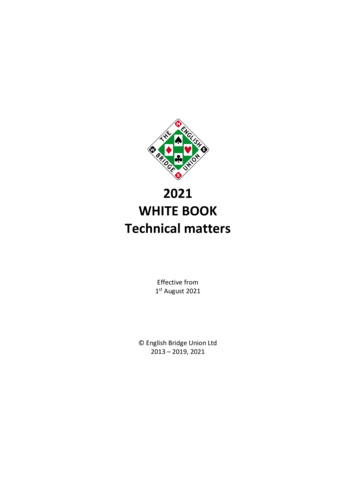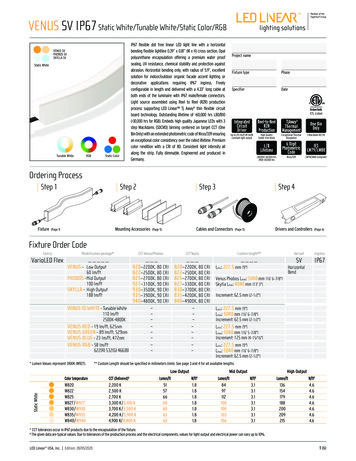
Transcription
White Paper: September 2021Internal Firewall: TheBest Way to ProtectEast-West Traffic
Internal Firewall: The Best Way to Protect East-West TrafficTable of contentsIntroduction. . . . . . . . . . . . . . . . . . . . . . . . . . . . . . . . . . . . . . . . . . . . . . . . . . . . . . 3Protecting the brand with intrinsic security . . . . . . . . . . . . . . . . . . . . . . . . . . . . . 3Mitigating risk . . . . . . . . . . . . . . . . . . . . . . . . . . . . . . . . . . . . . . . . . . . . . . . . . . . 4Enabling compliance. . . . . . . . . . . . . . . . . . . . . . . . . . . . . . . . . . . . . . . . . . . . . . . 5Simplifying security architecture, scaling operatons and supportiingbusiness agility . . . . . . . . . . . . . . . . . . . . . . . . . . . . . . . . . . . . . . . . . . . . . . . . . . . 6Conclusion. . . . . . . . . . . . . . . . . . . . . . . . . . . . . . . . . . . . . . . . . . . . . . . . . . . . . . . 8White Paper 2
Internal Firewall: The Best Way to Protect East-West TrafficIT security professionals wantapplication-centric, built-In,cross-platform security control1 Approximately half are managing morethan 20 agents. 60 percent prefer built-in securitycontrols over agent-based solutions. 70 percent agree security controlsshould be built in to the hypervisor.IntroductionEven in the best of times, chief information security officers (CISOs) and theirteams face numerous challenges in protecting the brand, the business andsensitive data against ever-changing threats—all with finite and constrainedresources. Today, those challenges are more extreme than ever. In a rapidlychanging world, CISOs need a way to defend the growing number of dynamicworkloads and increasing internal network traffic against cyberattacks.Traditional security approaches are not the answer. Bolted-on security solutionscan’t deliver the scalability, flexibility and cost effectiveness needed by today’ssecurity teams. Instead, enterprises should insist on intrinsic security—securitybuilt in to the infrastructure, distributed and application aware.This white paper explains why intrinsic security, in the form of a Distributedfirewall, is essential for protecting the brand. It highlights three examples of howVMware customers use the VMware Distributed Firewall to mitigate risk, complywith policies and standards, and improve agility while scaling seamlessly andcost effectively along with the business. The Distributed Firewall is a distributed,scale-out internal firewall that protects all east-west traffic with security that’sintrinsic to the infrastructure, radically simplifying the deployment model.Protecting the brand with intrinsic securityCISOs aren’t the only ones dealing with the pressures of rapid change. Softwareengineering teams are tasked with continuous innovation and expected todeliver new features and new code deployments weekly or even daily. Toachieve this level of agility, application architectures shift from a monolithicapproach (where changes require redeploying the entire application) to adistributed one (where changes can be made quickly to small, independentservices without having to redeploy the entire system). In a distributedarchitecture, each application becomes a network unto itself, with communicationin the form of network traffic between different workloads and microservices.Network security controls invented in the era of monolithic applications or eventhree-tier applications are no longer adequate to protect present-day applicationinfrastructure. Traditional security controls lack awareness of intra-applicationtraffic flows. As application infrastructures evolved, security teams added moresecurity tools to try to protect dynamic workloads, which led to tool sprawl,higher total cost of ownership, operational complexity and the need to tradenecessary security controls for speed to market when it came to new capabilities.For all these reasons, security organizations began adopting a far more effectiveapproach to securing workloads and sensitive data: intrinsic security. Built in tothe IT architecture instead of being bolted on, intrinsic security is distributed,application aware and simple to operate.1. Forrester Consulting. “To Enable Zero Trust, Rethink Your Firewall Strategy.” February 2020.White Paper 3
Internal Firewall: The Best Way to Protect East-West TrafficFurther readingTo learn more about the challenges oftraditional network security controlsfor protecting modern workloads, readFive Critical Requirements for InternalFirewalling in the Data Center.An internal firewall with intrinsic security, like that from VMware, protectsworkloads while eliminating the complexity and expense of multiple, bolted-onsecurity solutions. The VMware Distributed Firewall—which includes adistributed firewall, an intrusion detection system and intrusion preventionsystem (IDS/IPS), and deep analytics through VMware NSX Intelligence (see Figure 1)—improves the security of today’s modern workloads. It helpsCISOs and their teams protect the brand, the business and sensitive data againstcyberthreats by mitigating risk with an intrinsic security approach that enablescompliance, and simplifies and scales operations cost effectively and withoutcompromising security.FIGURE 1: The VMware Distributed Firewall.Mitigating riskThe traditional castle-and-moat perimeter security model is inadequate forprotecting modern IT environments. Instead, new approaches such as zero trustcall for monitoring and protecting traffic within the data center on the principlethat no traffic should be trusted until policy proves otherwise.Micro-segmentation is one of the core concepts within the zero-trust model. Itinvolves isolating workloads from each other and securing each of them individually.For organizations with large numbers of applications and workloads, segmentationis often implemented incrementally, starting with macro-segmentation of specificenvironments (such as development from production), then with microsegmentation of the virtual desktop infrastructure or other single applicationenvironments, and finally with micro-segmentation of all applications.An internal firewall is the most efficient and effective way to deploy networksegmentation in support of a zero-trust approach because the firewall can: Analyze every packet and workload in east-west (internal) traffic to detectand block threats.White Paper 4
Internal Firewall: The Best Way to Protect East-West Traffic Use deep application awareness and visibility alongside detailed identificationof application topology to monitor all traffic flows. Provide granular control at the service level with automated policyrecommendations.Customer experience: Deploying micro-segmentation in afinancial institutionA large financial institution that offers banking and other financial services tomore than 30,000 customers and manages more than 800 million in assetswanted to move to a zero-trust security model to better protect customers’personal and financial information. The CIO made the decision that all traffic,including all east-west (internal) traffic, would be secured. To effectively adoptzero trust, the financial institution needed a way to: Easily segment applications to prevent the lateral movement of threats. Minimize the expense and burden of a zero-trust deployment on thefive-person security operations team. Accommodate potential future use cases, such as edge servicesand multi-cloud environments.The financial institution chose the VMware Distributed Firewall to enablemicro-segmentation of all applications to block lateral movement of cyberattackers.In a matter of weeks, the security operations team went from planning toproduction with its first micro-segmented application. In a few months’ time,the team discovered and secured all applications within the data center.Using the Distributed Firewall, the security operations team was able toimplement zero trust quickly throughout the entire environment while keepingcosts low by automating network and security configurations. Standardizing onthe Distributed Firewall allowed the financial institution to remove multiplelegacy tools, use a single pane of glass for security management and significantlyimprove the IT team’s operational efficiency while mitigating risk.Enabling complianceNot only do companies need to comply with all applicable laws, rules andregulations, but many organizations also have internal rules, policies andprocedures that must be followed. Whether it’s a mandate—such as the HealthInsurance Portability and Accountability Act (HIPAA), the Payment Card IndustryData Security Standard (PCI DSS) or the Sarbanes-Oxley Act (SOX)—or internalrules and regulations, CISOs and their teams have to implement and enforcecompliance requirements.Meeting compliance requirements necessitates the ability to create andpropagate specific security policies to all relevant workloads, and track trafficflows to and from sensitive applications. An internal firewall eases the cost,complexity and effort of compliance while fulfilling security requirements by:White Paper 5
Internal Firewall: The Best Way to Protect East-West Traffic Tracking and inspecting all traffic to and from sensitive applications to eliminateblind spots Streamlining the creation and customization of multiple, virtual security zonesfor sensitive applications Automatically creating, distributing, moving and decommissioning policiesaccording to each sensitive workload’s lifecycleCustomer experience: Securing electronic health records forregulatory complianceTo comply with HIPAA, a large health system with thousands of physicians andnurses needed to implement and enforce fine-grain access controls to protectpatient data within its electronic health record (EHR) system. Traditional,hardware-based firewalls would not be able to scale to accommodate the rulesrequired and would create management complexity as rules needed to bechanged.If the health system used its perimeter firewall as an internal firewall, the healthsystem would need to manually create new security policies and modify themwhenever a workload was moved or decommissioned, which could lead topotential configuration errors and take time away from other security efforts.With the VMware Distributed Firewall, the health system moved from design toproduction in just six weeks. The security team used the internal firewall fromVMware to segment and protect the EHR system with granular security policiesautomatically propagated to all relevant workloads. The internal firewallnow tracks all traffic flows to and from the EHR.After deployment, the health system experienced a ransomware attack but,because each of the subcomponents of the EHR application was secured bythe Distributed Firewall, the system blocked the lateral movement of the threatinto the EHR environment. The EHR application and sensitive patient recordsremained protected from and unaffected by the attack.Simplifying security architecture, scaling operationsand supporting business agilityAs more monolithic applications are replaced with or rearchitected intodistributed applications, the number of workloads and the volume of trafficbetween those workloads has increased exponentially. Security teams need away to keep up with the speed of development and the pace of the business.To gain this agility, internal firewalls must be easily scalable and simple tomanage to efficiently protect the growing number of workloads—and the brand.White Paper 6
Internal Firewall: The Best Way to Protect East-West TrafficCAPEX savingsBy implementing the VMware DistributedFirewall, enterprise customers could seea reduction of up to 60 percent in thenumber of traditional firewalls required.2When used to monitor internal traffic, traditional perimeter firewalls limitscalability because they force the traffic to be hair-pinned through a centralizedappliance. In addition to causing performance bottlenecks and latency issues,traditional firewalls create further complexity because they don’t easily supportthe creation and management of security groups for network segmentation.Implementing policies such as those needed to secure complex, modernapplications can require thousands of rules using a traditional firewall.To simplify operations while scaling seamlessly and cost effectively as they supportchange and growth in the distributed application environment, security operationsteams need an internal firewall that can: Support virtual security zones (network segments) without enormous costand constraint on traffic volume and policies. Automatically manage security policies across the lifecycle of thousands ofhosts and workloads. Reduce capital expenditures by replacing multiple discrete appliances.Customer experience: Replacing hundreds of appliancesTo protect a business-critical, consumer-facing mobile application, a globaltelecommunications company with 400 million users in more than a dozen countriesneeded to segment and secure large amounts of network traffic on its in-houseinfrastructure. The company’s hardware-based firewall could not scale to protectall workloads and traffic across dev/test, production and demilitarized zones.Because the traffic was hair-pinned to and from the firewall appliances, thecompany experienced performance issues during traffic spikes when newversions of the application were released. The traditional firewall also did nothave enough capacity in its rule tables to support all the rules required toprotect the application’s complex back-end infrastructure.The telecommunications company is replacing more than 200 firewall applianceswith the VMware Distributed Firewall, giving it a single firewall model andmanagement console for the entire infrastructure. VMware simplifies operationsfor the company and eliminates performance bottlenecks. Within the DistributedFirewall, security tags simplify management of firewall rules by allowing policiesto be expressed using tags rather than an IP address. This gives the companygreater agility and speed for adding new workloads, and moving ordecommissioning existing ones.2. VMware. Internal projection based on analysis of 192 customer ROI models using the Data IntegratedCustomer Engagement (DICE) business case tool. January 2020.White Paper 7
Internal Firewall: The Best Way to Protect East-West TrafficConclusionSavvy CISOs across many industries have already discovered they can dramaticallyreduce cost and complexity, and improve scalability, when securing internalworkloads and traffic by implementing an internal firewall. Instead of relying ontraditional, bolted-on security solutions, these organizations turn to intrinsicsecurity—built in, distributed and application-aware—to protect the brand.With the VMware Distributed Firewall, companies gain a distributed,scale-out internal firewall that protects all east-west traffic to mitigate riskand enable compliance. By reinventing the internal firewall deployment model,the Distributed Firewall simplifies operations with security that’s intrinsicto the infrastructure.White Paper 8
Copyright 2021 VMware, Inc. All rights reserved. VMware, Inc. 3401 Hillview Avenue Palo Alto CA 94304 USA Tel 877-486-9273 Fax 650-427-5001VMware and the VMware logo are registered trademarks or trademarks of VMware, Inc. and its subsidiaries in the United States and other jurisdictions. All other marks and namesmentioned herein may be trademarks of their respective companies. VMware products are covered by one or more patents listed at vmware.com/go/patents.Item No: vmw-wp-best-way-to-protect-traffic-uslet-v1 9/21
Internal Firewall: The Best Way to Protect East-West Traffic IT security professionals want application-centric, built-In, . Instead, enterprises should insist on intrinsic security—security built in to the infrastructure, distributed and application aware . This white paper explains why intrinsic security, in the form of a Distributed .











